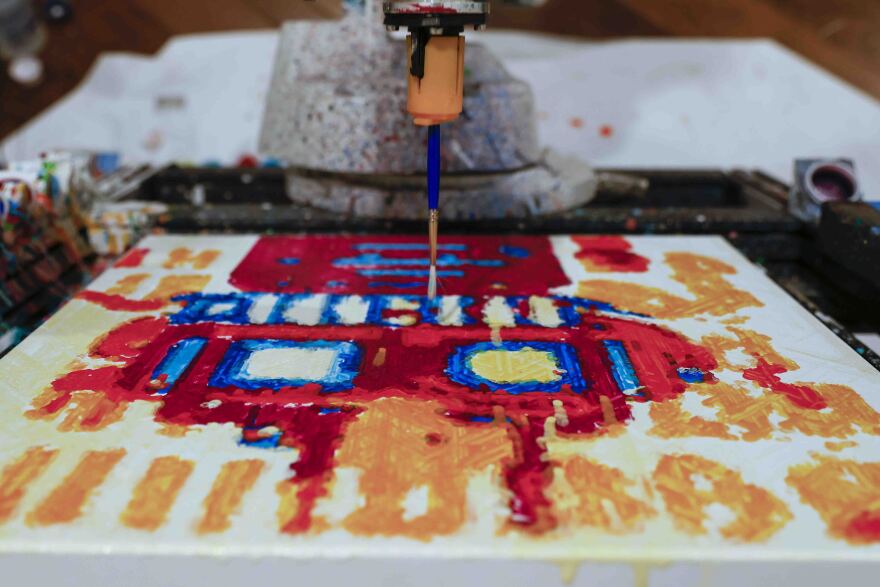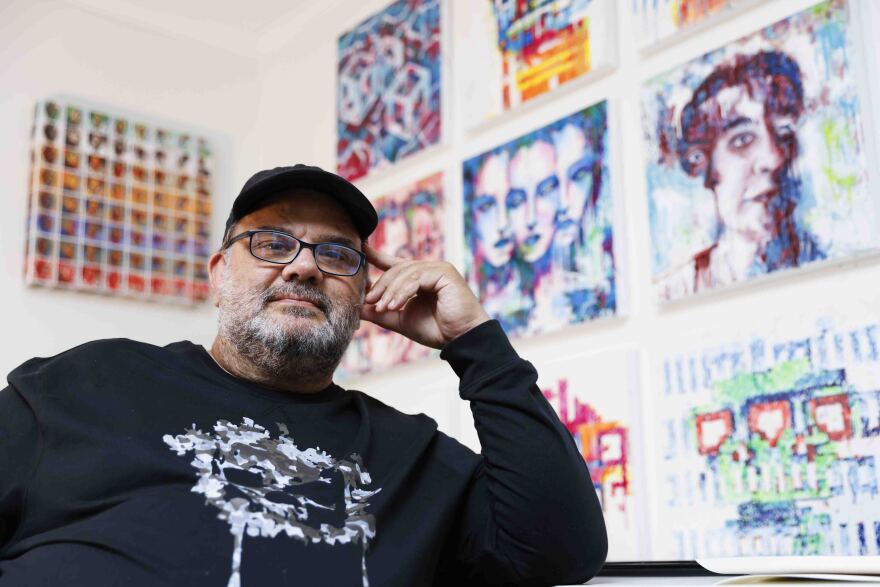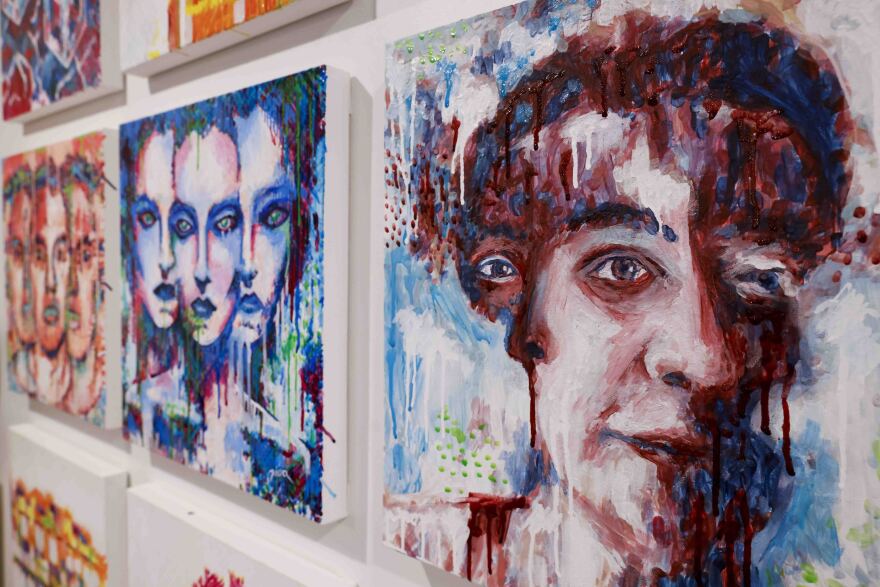Robots painting like humans. Photographers generating portraits with text prompts. People writing poems, plays and essays with ChatGPT. Artificial intelligence is redefining art.
But along with the innovation, some artists and art leaders are raising ethical and legal concerns about AI art. Some artists worry AI will threaten their jobs. Others are questioning the ethics of AI art as research shows the influence of racial, socioeconomic and other biases in works produced by AI.
Pindar Van Arman, who is based in Fort Worth, has been an AI artist for almost 20 years and has seen the field evolve over time. Van Arman, who has a background in robotics, is known for creating robots that can paint like humans. In this interview, he shares his thoughts on bias, transparency, serendipity and more when it comes to artwork made by AI.

I read an artist statement online and you said “my machines have grown beyond being simple assistants and are now effectively augmenting my own creativity as well as having creativity of their own.” So how can a robot be creative, and in what ways is it changing your own creativity?
A similar question I've been asked is, ‘When you paint on your own, does it look like your robot's or does your robot's look like [yours]?’ And one of the things I do is I try and train my robots to have a style to paint like me and to paint how I would paint, to mimic me. They’re like my studio assistants.
But that's not to say that they're 100% painting like I am, because over 20 years, I've learned to paint like it and our styles have merged.
Whenever I have a creative block and I don't know what to do, I just force myself to turn on the robot and it's going to come up with the design, it's going to come up with a theme, it's going to come up with a direction, and then I can jump in after it. It’s kind of funny that it's taking the lead in creativity in those instances.
The art community seems to have a range of opinions when it comes to AI art, but it seems like a good amount of artists are concerned that AI will threaten their role or their livelihood. So is that a concern that you share?
I don't fear competition from AI more than I fear competition from a new student coming out of art school. So would AI take away jobs from artists? Not in the art sphere, but perhaps in the commercial sphere.
More common artistic tasks are being replaced by AI. One job that I've heard that's actually being affected is, for example, art directors at advertising agencies used to have to make large storyboards for a commercial or to pitch an idea.
But to be an artist is that you're making art that connects to someone, makes them think, and it talks about the human condition.

There's been so much pushback about AI learning from artwork and images online without compensating or acknowledging artists. And some artists are pushing for greater protections for intellectual property. So do you think there needs to be greater transparency and protections?
An artist goes and gets inspired by a hundred works of abstract expressionists, same way that AI gets inspired. So there's really no reason why it's bad that the AI is being inspired by all these different artists and making something new out of all of the art that's been before it. Nothing wrong with that.
The problem I have is when people use AI to recreate the style of artists and advertise it as that style of artist. For example, if they were to create a new Picasso and use nothing but Picasso prompts and images in their AI and say, “Hey, this is Picasso 2023” and sell something as a Picasso, what Picasso would imagine in 2023. I find that exploitative of the artists, exploitative of the art.
It’s really trying to monetize an artist's work without compensating that artist at all. But even worse, without getting that artist's permission, because you don't know if Picasso would be okay with these new images made in his art’s likeness. So I see a lot of that.
Another concern that I think a lot of folks are having is that research shows that it [AI] kind of reflects human biases and people think it'll worsen racial, economic or gender inequities. For example, I know that Lensa was recently criticized for producing really hypersexualized images. So are you concerned about this bias when it comes to art?
Yeah, I am. That problem is absolutely true. I saw a photography exhibition recently and someone says, “Why do all the women in this look like Cara Delevingne?” You know, Cara Delevingne has these really strong eyebrows and hollow cheeks, and you look at things like, “Absolutely, it's almost as if someone used the prompt: Cara Delevingne.”
You see all our natural biases – what we'd like to have more pictures of in the models. Yeah, I agree with that completely. Completely biased and it [AI] is amplifying it.

We've been talking a lot about issues of accessibility that people are concerned about with AI. Is there anything else you'd like to share?
While AI does worry me with some things, AI has also made great democratization. Anyone can now be an artist, anyone. It used to be only I, as a roboticist, as like a real tech nerd, had access to powerful enough GPUs [graphics processing unit] to make AI art. Now anyone can sign up for some GPU time and make high end stuff, better than I could make. There are GPUs out there that are available for very inexpensive rent, hours at a time. I had to once spend $20,000 on GPUs. That was restrictive.
So as far as access, much more accessible now, much more democratic and that’s an interesting thing that's happened. Some artists are coming out of nowhere that never made art before. They're making gorgeous art and no technical requirements, no educational requirement, no requirements at all.
I feel like a huge part of art is the process of making mistakes and kind of turning that into art, making it a part of the art. But robots aren't designed to make mistakes. So how do you think about this idea of mistakes or serendipity in the process of art making?
Actually, serendipity is a big part of my art making process because some people think robots don't make mistakes. But, a big part of my robot is to take pictures of what it's doing and react to what it's doing and then use that as inspiration.
So I intentionally use very runny paints. If you look at my paintings, you'll see [the robot] often paints too much in one area, the image starts to drip and it sees the picture, then it tries to go and repair it. Some people add serendipity with random number generation. I add serendipity to my paintings and it does bring them to life by letting the robots make mistakes.
A calm portrait of a face will turn into a chaotic three-figured monster, it's really fun and it's really unexpected. I think it's key to making really good generative art that doesn't look or feel like generative art.

What do you think art or art making will look like in a decade or two when your children are adults?
I think it’ll look the same. All the artists are just trying to tell an interesting story about the human condition and AI are not. [That’s] going to be very similar.
We might be joined by AI artists in that time. But I'm not sure AI artists will appeal to humans because I don't know if I care that much about what it is to be an AI in the universe. There might be some AI art that I relate to like “Ah, this AI really gets it.”
But I still think I’ll continue to love human artists that talk to my condition, my experience, and what we're doing on this planet. So I think it'll look very similar with perhaps some stuff that looks totally alien that we don't even understand. But that'll be for the AI.
This interview has been lightly edited for clarity.
Arts Access is a partnership between The Dallas Morning News and KERA that expands local arts, music and culture coverage through the lens of access and equity.
This community-funded journalism initiative is funded by the Better Together Fund, Carol & Don Glendenning, City of Dallas OAC, Communities Foundation of Texas, The Dallas Foundation, Eugene McDermott Foundation, James & Gayle Halperin Foundation, Jennifer & Peter Altabef and The Meadows Foundation. The News and KERA retain full editorial control of Arts Access’ journalism.





